 The emerald has been a gem of fascination for over six thousand years. It is so prized that a fine emerald may be twice as valuable as a
The emerald has been a gem of fascination for over six thousand years. It is so prized that a fine emerald may be twice as valuable as a ![]() diamond. Emerald was first translated from Sanskrit as "marakata," meaning "the green of growing things." The name we know it as now is believed to come from an ancient Persian word, "smaragdus." Over time, it was corrupted to "emerald." Records show that the stone was known and sold in markets in Babylon as early as 4000 BC. The stone was worshiped by the Incas and mentioned in biblical information about the apocalypse. The earliest reference to emeralds in Western literature comes from Aristotle. He was a great fan of the gemstone. He wrote that owning an emerald increases the owner's importance in business and gives victory in trials. It also helps settle litigation and comforts and soothes eyesight. He also stated, "An emerald hung from the neck or worn in a ring will prevent the falling sickness (epilepsy). We, therefore, commend noblemen that it be hanged about the necks of their children that they fall not into this complaint."
diamond. Emerald was first translated from Sanskrit as "marakata," meaning "the green of growing things." The name we know it as now is believed to come from an ancient Persian word, "smaragdus." Over time, it was corrupted to "emerald." Records show that the stone was known and sold in markets in Babylon as early as 4000 BC. The stone was worshiped by the Incas and mentioned in biblical information about the apocalypse. The earliest reference to emeralds in Western literature comes from Aristotle. He was a great fan of the gemstone. He wrote that owning an emerald increases the owner's importance in business and gives victory in trials. It also helps settle litigation and comforts and soothes eyesight. He also stated, "An emerald hung from the neck or worn in a ring will prevent the falling sickness (epilepsy). We, therefore, commend noblemen that it be hanged about the necks of their children that they fall not into this complaint."
 Many cultures have believed the emerald gemstone to be an enormously powerful stone. The Chaldeans believed the stone contained a goddess. In the Islamic faith, an amulet of an emerald might be engraved with a verse from the Koran. The ancient Egyptians believed the emerald stood for fertility and rebirth. In Ancient Rome, Nero supposedly watched gladiator fights through a large transparent emerald. He found the color calming. In some legends of King Arthur, the Holy Grail is described as fashioned from an emerald. In China, Thursday was the day for wearing green and emeralds for good luck. However, various countries in the East and West varied in opinion on which day the emerald would bring good luck. The Romans once considered light-colored Emeralds unripe. They believed that an Emerald becomes a darker shade of green as it matures.
Many cultures have believed the emerald gemstone to be an enormously powerful stone. The Chaldeans believed the stone contained a goddess. In the Islamic faith, an amulet of an emerald might be engraved with a verse from the Koran. The ancient Egyptians believed the emerald stood for fertility and rebirth. In Ancient Rome, Nero supposedly watched gladiator fights through a large transparent emerald. He found the color calming. In some legends of King Arthur, the Holy Grail is described as fashioned from an emerald. In China, Thursday was the day for wearing green and emeralds for good luck. However, various countries in the East and West varied in opinion on which day the emerald would bring good luck. The Romans once considered light-colored Emeralds unripe. They believed that an Emerald becomes a darker shade of green as it matures.
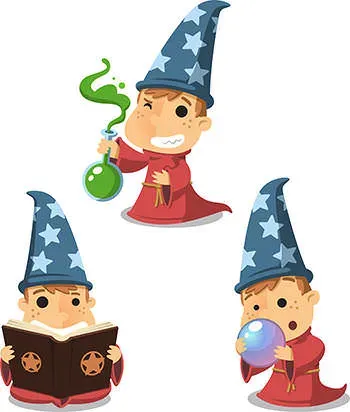 There have been many beliefs that the emerald stone brings goodness into one's life. In the second century BC, the Roman magician Damigeron praised the gem. He stated that an emerald "influences every kind of business, and if you remain chaste while you wear it, it adds substance to both the body and the speech." The second-century Mahabharata also commended the stone. The emerald has always been seen as a symbol of fidelity. During the Middle Ages, it was believed to keep a woman chaste. Not surprisingly, the same was not considered valid for a man. It was also stated that emeralds enable people to foretell future events. When put on the tongue or worn on the left side of the body. Emeralds were believed to reveal what was true or false and were said to be a sure antidote for enchantments and spells. They were also said to make people more intelligent and honest. Emeralds are believed to contain the energy necessary to bring creative form to your work. It was once thought that a high-quality emerald would change hues to alert the wearer to impending danger. They also help one express love, devotion, and adoration.
There have been many beliefs that the emerald stone brings goodness into one's life. In the second century BC, the Roman magician Damigeron praised the gem. He stated that an emerald "influences every kind of business, and if you remain chaste while you wear it, it adds substance to both the body and the speech." The second-century Mahabharata also commended the stone. The emerald has always been seen as a symbol of fidelity. During the Middle Ages, it was believed to keep a woman chaste. Not surprisingly, the same was not considered valid for a man. It was also stated that emeralds enable people to foretell future events. When put on the tongue or worn on the left side of the body. Emeralds were believed to reveal what was true or false and were said to be a sure antidote for enchantments and spells. They were also said to make people more intelligent and honest. Emeralds are believed to contain the energy necessary to bring creative form to your work. It was once thought that a high-quality emerald would change hues to alert the wearer to impending danger. They also help one express love, devotion, and adoration.
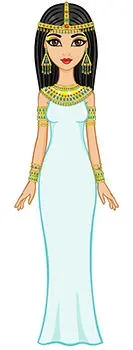 It was known that the emerald was a favorite gem of Cleopatra, the Queen of Egypt. The emerald mine in Upper Egypt, discovered a hundred years ago near the Red Sea, was one of the earliest emerald finds in human history. Emeralds also adorned Russian crown jewels. The Iranian State Treasure contains an exquisite collection of Emeralds. It includes the Emerald tiara of ex-Empress Farah. Shah Jahan, one of the moguls of India who built the Taj Mahal, loved Emeralds. He valued them so much that he had sacred texts inscribed into them and used them as talismans. The ancient writings of Veda, the holy text of Hinduism, testify to the emerald as the "gem of good luck" and the "gem that improves one's well-being." These "Mogul Emeralds," as they are known today, can be found in modern museums and collections.
It was known that the emerald was a favorite gem of Cleopatra, the Queen of Egypt. The emerald mine in Upper Egypt, discovered a hundred years ago near the Red Sea, was one of the earliest emerald finds in human history. Emeralds also adorned Russian crown jewels. The Iranian State Treasure contains an exquisite collection of Emeralds. It includes the Emerald tiara of ex-Empress Farah. Shah Jahan, one of the moguls of India who built the Taj Mahal, loved Emeralds. He valued them so much that he had sacred texts inscribed into them and used them as talismans. The ancient writings of Veda, the holy text of Hinduism, testify to the emerald as the "gem of good luck" and the "gem that improves one's well-being." These "Mogul Emeralds," as they are known today, can be found in modern museums and collections.
 According to legend, Hernando Cortes, the conqueror of Mexico, attempted to transport large pieces of emerald he had taken from the Aztecs back to his homeland. Unfortunately, one of his ships met with disaster during the voyage and sank. This tragedy resulted in the loss of exquisitely crafted emeralds resembling flowers, fish, and other rare emeralds. One of the emeralds was as large as a man's palm and was forever lost.
According to legend, Hernando Cortes, the conqueror of Mexico, attempted to transport large pieces of emerald he had taken from the Aztecs back to his homeland. Unfortunately, one of his ships met with disaster during the voyage and sank. This tragedy resulted in the loss of exquisitely crafted emeralds resembling flowers, fish, and other rare emeralds. One of the emeralds was as large as a man's palm and was forever lost.
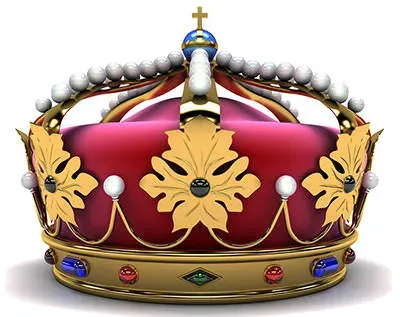 Throughout history, emeralds have been prized and worn by royalty and celebrities. In the first century BC, the King of Egypt had an emerald engraved with the portrait of Lucullus, a great Roman general. He then presented it to him when Lucullus visited Egypt. Cleopatra's mines now only yield poor-quality emeralds. But when she was queen, it turned out many stones, some of which you can see in museums worldwide. Alexander the Great had a large emerald set into his girdle. Charlemagne had a collection of emeralds. Henry II received a sizeable emerald ring when he was made King of Ireland in 1171. Queen Elizabeth II had a fantastic collection of emerald jewelry, including an emerald diadem. In modern times, in many of her movies, Marlene Dietrich wore her collection of dramatic jewelry set with giant cabochon emeralds. Grace Kelly, another icon, was given a 12-carat emerald-cut
Throughout history, emeralds have been prized and worn by royalty and celebrities. In the first century BC, the King of Egypt had an emerald engraved with the portrait of Lucullus, a great Roman general. He then presented it to him when Lucullus visited Egypt. Cleopatra's mines now only yield poor-quality emeralds. But when she was queen, it turned out many stones, some of which you can see in museums worldwide. Alexander the Great had a large emerald set into his girdle. Charlemagne had a collection of emeralds. Henry II received a sizeable emerald ring when he was made King of Ireland in 1171. Queen Elizabeth II had a fantastic collection of emerald jewelry, including an emerald diadem. In modern times, in many of her movies, Marlene Dietrich wore her collection of dramatic jewelry set with giant cabochon emeralds. Grace Kelly, another icon, was given a 12-carat emerald-cut ![]() diamond engagement ring from Prince Rainier. In National Geographic's emerald story, we have also seen the elegant Elizabeth Taylor in her emerald jewelry. Richard Burton gave her the emerald and diamond brooch as an engagement present. She wore them with an emerald necklace he gave her as a wedding present. Earrings, a bracelet, and a ring followed. Some emeralds in Taylor's set were from the Grand Duchess Vladimir in Russia. John F. Kennedy gave Jacqueline Bouvier a 2.88-carat diamond emerald ring. Sharon Stone was given a three-diamond, 3 1/2 carat emerald-cut diamond engagement ring by Phil Bronstien.
diamond engagement ring from Prince Rainier. In National Geographic's emerald story, we have also seen the elegant Elizabeth Taylor in her emerald jewelry. Richard Burton gave her the emerald and diamond brooch as an engagement present. She wore them with an emerald necklace he gave her as a wedding present. Earrings, a bracelet, and a ring followed. Some emeralds in Taylor's set were from the Grand Duchess Vladimir in Russia. John F. Kennedy gave Jacqueline Bouvier a 2.88-carat diamond emerald ring. Sharon Stone was given a three-diamond, 3 1/2 carat emerald-cut diamond engagement ring by Phil Bronstien.
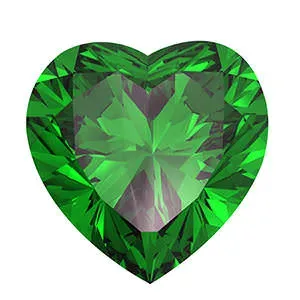 The ancients associated the emerald with the Greek goddess Venus, the goddess of love and beauty. It was said to protect lovers from unfaithfulness. If the heart were loyal, the gem would glow in a beautiful green color, but if it went astray, it would turn a different, lifeless color. In addition, people believed that wearing an Emerald would improve one's memory and intelligence, enabling one to think clearly about the past, present, and future.
The ancients associated the emerald with the Greek goddess Venus, the goddess of love and beauty. It was said to protect lovers from unfaithfulness. If the heart were loyal, the gem would glow in a beautiful green color, but if it went astray, it would turn a different, lifeless color. In addition, people believed that wearing an Emerald would improve one's memory and intelligence, enabling one to think clearly about the past, present, and future.
 Emerald plays a vital role in religion, as well. Green is the holy color of Islam, and the states belonging to the Arab world possess green banners symbolizing the unity of Islam. In the Catholic Church, green also has a special meaning since it has always been considered the most natural and elementary color in liturgy. Some say an Emerald shaped like a bowl fell off Satan's crown. Christ later used that bowl at the Last Supper. Joseph of Arimathea caught Christ's blood dripping from the cross in that bowl, founding the order of the Holy Grail.
Emerald plays a vital role in religion, as well. Green is the holy color of Islam, and the states belonging to the Arab world possess green banners symbolizing the unity of Islam. In the Catholic Church, green also has a special meaning since it has always been considered the most natural and elementary color in liturgy. Some say an Emerald shaped like a bowl fell off Satan's crown. Christ later used that bowl at the Last Supper. Joseph of Arimathea caught Christ's blood dripping from the cross in that bowl, founding the order of the Holy Grail.
 Since as far back as there is evidence of emeralds, there has been evidence of its healing powers. Some said emeralds would heal if worn, and others said gaining help required gazing deeply into the green for a while. In every language, there were reports of the emerald helping eyesight. The Sumerians said that if they wore an emerald in a ring on the little finger of the left hand, it would cure inflammation of the eyes. During Hippocrates, emeralds were crushed into a fine powder and made into an eye lotion.
Since as far back as there is evidence of emeralds, there has been evidence of its healing powers. Some said emeralds would heal if worn, and others said gaining help required gazing deeply into the green for a while. In every language, there were reports of the emerald helping eyesight. The Sumerians said that if they wore an emerald in a ring on the little finger of the left hand, it would cure inflammation of the eyes. During Hippocrates, emeralds were crushed into a fine powder and made into an eye lotion.
 Some people have believed that emeralds have healing powers for various body parts like the bones, skin, heart, kidneys, and more. People thought they could also keep you healthy by preventing infections and diseases. In the past, some thought that if a mom-to-be wore emeralds, it would protect her and her baby during childbirth. A guy named Paracelsus even said that mixing emeralds with a substance called laudanum, which comes from opium, could treat specific illnesses and fevers. People believed emeralds could cure problems like stomach pain, burns, headaches, and even severe diseases like cancer. Emeralds were even used as a remedy if someone got poisoned. Nowadays, some Chinese folk medicines still use lower-quality emeralds ground into a powder for treatments.
Some people have believed that emeralds have healing powers for various body parts like the bones, skin, heart, kidneys, and more. People thought they could also keep you healthy by preventing infections and diseases. In the past, some thought that if a mom-to-be wore emeralds, it would protect her and her baby during childbirth. A guy named Paracelsus even said that mixing emeralds with a substance called laudanum, which comes from opium, could treat specific illnesses and fevers. People believed emeralds could cure problems like stomach pain, burns, headaches, and even severe diseases like cancer. Emeralds were even used as a remedy if someone got poisoned. Nowadays, some Chinese folk medicines still use lower-quality emeralds ground into a powder for treatments.
 The remedial use of emeralds has many positive attributes for the mind and the spirit. It is said to detoxify negativity and transform it into positive emotional energy. It stabilizes, soothes, and offers security, harmony, and closeness to God. It increases one's life purpose concerning the universal plan and aids in emotional life and life transitions. It keeps the mind in excellent condition and also promotes a healthy memory. In today's world, it is a perfect stone for someone involved in public speaking. Emeralds are known to be calming and balancing, promoting creativity and eloquence and restoring faith and hope. They are believed to bring good fortune and are used to kindle kindness and sympathy. They also improve one's intuition, thereby increasing one's perception. They bring out truthfulness and are symbols of love. There have even been times when people believed the emerald could control one's passions and lusts. Today, they represent the balance between perfect love and trust while carrying the virtue of protection.
The remedial use of emeralds has many positive attributes for the mind and the spirit. It is said to detoxify negativity and transform it into positive emotional energy. It stabilizes, soothes, and offers security, harmony, and closeness to God. It increases one's life purpose concerning the universal plan and aids in emotional life and life transitions. It keeps the mind in excellent condition and also promotes a healthy memory. In today's world, it is a perfect stone for someone involved in public speaking. Emeralds are known to be calming and balancing, promoting creativity and eloquence and restoring faith and hope. They are believed to bring good fortune and are used to kindle kindness and sympathy. They also improve one's intuition, thereby increasing one's perception. They bring out truthfulness and are symbols of love. There have even been times when people believed the emerald could control one's passions and lusts. Today, they represent the balance between perfect love and trust while carrying the virtue of protection.
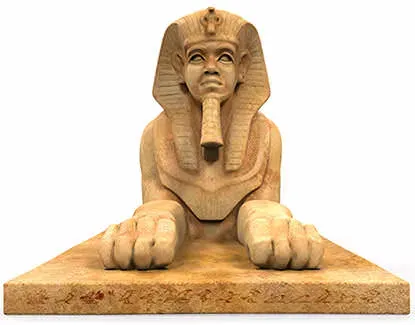 Emeralds can be found in granites, pegmatites, schists, and alluvial deposits. Some emeralds find their way into gravels where the action of the water tumbles and smoothes them so they resemble shiny pebbles. The first known emerald mines were in Southern Egypt and show evidence of being worked in since 2000 BC. Some of the finest stones today come from Columbia, the best from the Chivor and Muzo mines. Much smaller quantities of medium-light color emeralds come from Brazil. Emeralds come from Austria, India, Australia, Brazil, South Africa, Egypt, the USA, Norway, and Pakistan. In the last few decades, increasing emeralds have also been found in Zimbabwe, Zambia, and Tanzania. These stones are a solid color, as are those from India, Pakistan, and the Soviet Union.
Emeralds can be found in granites, pegmatites, schists, and alluvial deposits. Some emeralds find their way into gravels where the action of the water tumbles and smoothes them so they resemble shiny pebbles. The first known emerald mines were in Southern Egypt and show evidence of being worked in since 2000 BC. Some of the finest stones today come from Columbia, the best from the Chivor and Muzo mines. Much smaller quantities of medium-light color emeralds come from Brazil. Emeralds come from Austria, India, Australia, Brazil, South Africa, Egypt, the USA, Norway, and Pakistan. In the last few decades, increasing emeralds have also been found in Zimbabwe, Zambia, and Tanzania. These stones are a solid color, as are those from India, Pakistan, and the Soviet Union.
 Only the finest quality emeralds are clear and flawless. Most have tiny mineral inclusions or fractures, referred to as "jardin," from the French word garden. This term refers to the moss or branch-like appearance of the flaws. Flawless emeralds are rare, precious, and usually only found in small sizes. There are fewer fine large emeralds in the world than there are diamonds! Most large emeralds have cracks and flaws or are cloudy in color. Oiling these emeralds to disguise the flaws and enhance the hue is common. The inclusions are sometimes invisible to the naked eye, especially in high-quality stones. These are very faint and only appear in 10x, 20x, or 40x lenses.
Only the finest quality emeralds are clear and flawless. Most have tiny mineral inclusions or fractures, referred to as "jardin," from the French word garden. This term refers to the moss or branch-like appearance of the flaws. Flawless emeralds are rare, precious, and usually only found in small sizes. There are fewer fine large emeralds in the world than there are diamonds! Most large emeralds have cracks and flaws or are cloudy in color. Oiling these emeralds to disguise the flaws and enhance the hue is common. The inclusions are sometimes invisible to the naked eye, especially in high-quality stones. These are very faint and only appear in 10x, 20x, or 40x lenses.
 Emeralds are brittle and easily fractured during handling and setting. They are not as hard as diamonds but do last a long time. They scratch easily, but a jeweler can buff the scratches away. Emeralds range in color from light to dark green. The presence of chromium oxide and vanadium determines the shade of green. Throughout history, the emerald's green color has "entranced humankind." Its color symbolizes new life and the promise of spring, which is why it is the birthstone of May. Some call the green color of an emerald grass green, velvety grass green, or deep transparent grass green with a luster. A square cut to the emerald emphasizes the richness of color by leading the eye into it rather than deflecting attention away from it. Some people prefer the off shades of green that are imperfect.
Emeralds are brittle and easily fractured during handling and setting. They are not as hard as diamonds but do last a long time. They scratch easily, but a jeweler can buff the scratches away. Emeralds range in color from light to dark green. The presence of chromium oxide and vanadium determines the shade of green. Throughout history, the emerald's green color has "entranced humankind." Its color symbolizes new life and the promise of spring, which is why it is the birthstone of May. Some call the green color of an emerald grass green, velvety grass green, or deep transparent grass green with a luster. A square cut to the emerald emphasizes the richness of color by leading the eye into it rather than deflecting attention away from it. Some people prefer the off shades of green that are imperfect.
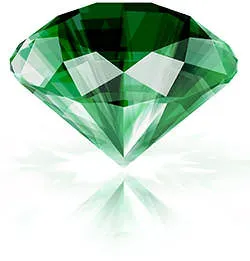 In ancient times, many gemstones were called emeralds because they were green. Today, about six or seven types of stones are called various kinds of emeralds. A genuine emerald, however, is called simply an emerald, with no qualifying name in front of it.
In ancient times, many gemstones were called emeralds because they were green. Today, about six or seven types of stones are called various kinds of emeralds. A genuine emerald, however, is called simply an emerald, with no qualifying name in front of it.
 Do not leave your emerald ring on while washing dishes or using soap, as an emerald will attract grease and soap. After a while, these substances will accumulate on the bottom of the gemstone, causing it to lose its lively brilliance. Also, do not wear your emerald when engaging in physical activity that might scratch the stone. To clean your emerald, use room temperature running water and a soft toothbrush with a mild soap like hand soap or Woolite. Brush repeatedly on the underside of the emerald to remove accumulations of dirt and grease. You will see the emerald begin to brighten. It should then be rinsed with warm water and patted dry.
Do not leave your emerald ring on while washing dishes or using soap, as an emerald will attract grease and soap. After a while, these substances will accumulate on the bottom of the gemstone, causing it to lose its lively brilliance. Also, do not wear your emerald when engaging in physical activity that might scratch the stone. To clean your emerald, use room temperature running water and a soft toothbrush with a mild soap like hand soap or Woolite. Brush repeatedly on the underside of the emerald to remove accumulations of dirt and grease. You will see the emerald begin to brighten. It should then be rinsed with warm water and patted dry.
 Do not clean an emerald with ultrasonic cleaners, steam cleaners, or acetone. These may cause damage to the stone or the setting. You should not expose your emeralds to high heat. A good rule of thumb is that if your cleaning solution is too hot to put your hand in, you should not place your emerald in it. Avoid using strong soaps, jewelry cleaner liquids, or other cleaners, as most of these are not compatible with the oil treatment of emeralds. It would be best to clean your emeralds only as frequently as necessary and never more than several times a year. After many years of wear, you may wish to have your emerald re-oiled. Most local jewelers can provide this service.
Do not clean an emerald with ultrasonic cleaners, steam cleaners, or acetone. These may cause damage to the stone or the setting. You should not expose your emeralds to high heat. A good rule of thumb is that if your cleaning solution is too hot to put your hand in, you should not place your emerald in it. Avoid using strong soaps, jewelry cleaner liquids, or other cleaners, as most of these are not compatible with the oil treatment of emeralds. It would be best to clean your emeralds only as frequently as necessary and never more than several times a year. After many years of wear, you may wish to have your emerald re-oiled. Most local jewelers can provide this service.